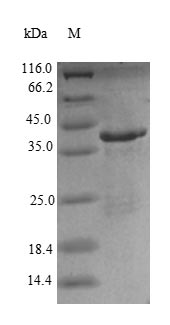The region for expressing recombinant Human ATP6AP2 contains amino acids 17-350. The theoretical molecular weight of the ATP6AP2 protein is 41.5 kDa. Expression of this ATP6AP2 protein is conducted in e.coli. The N-terminal 6xHis tag was fused into the coding gene segment of ATP6AP2, making it easier to detect and purify the ATP6AP2 recombinant protein in the later stages of expression and purification.
The renin receptor (ATP6AP2) is a protein that spans multiple research areas, exerting a significant influence on cardiovascular and renal physiology. One major research focus is its role in the renin-angiotensin-aldosterone system (RAAS), a critical regulatory system for blood pressure and fluid balance. ATP6AP2 acts as a receptor for renin, initiating a cascade reaction leading to the production of angiotensin II, a potent vasoconstrictor. In cardiovascular research, scientists explore the impact of ATP6AP2 on blood pressure regulation and its role in diseases such as hypertension and heart failure.






